Carbon steel forging is a widely used manufacturing process that involves shaping carbon steel through the application of compressive forces. This technique has gained popularity due to its numerous advantages, making it suitable for various applications across different industries. During the forging process, the internal structure of the material changes and the grains are refined, thereby improving its mechanical properties and durability. Through different forging processes, such as free forging, die forging, and hot forging, various complex shapes of parts can be produced to meet different engineering needs.

Advantages of Carbon Steel Forging
1. Enhanced Strength and Durability
One of the primary advantages of carbon steel forging is the enhanced strength and durability of the final product. The forging process aligns the grain structure of the steel, resulting in a denser and more robust material. This improved grain structure contributes to higher tensile strength and fatigue resistance, making forged components ideal for high-stress applications.
2. Improved Mechanical Properties
Forged carbon steel exhibits superior mechanical properties compared to its cast counterparts. The forging process reduces the presence of voids and inclusions, leading to a more uniform material. As a result, forged components can withstand extreme conditions, including high temperatures and pressures, making them suitable for demanding environments.
3. Cost-Effectiveness
While the initial investment in forging equipment may be higher than other manufacturing methods, carbon steel forging can be more cost-effective in the long run. The durability and strength of forged components often lead to reduced maintenance costs and longer service life. Additionally, the efficiency of the forging process allows for the production of complex shapes with minimal waste, further enhancing cost-effectiveness.
4. Versatility in Design
Carbon steel forging offers significant design flexibility. The process can accommodate a wide range of shapes and sizes, from simple components to intricate designs. This versatility allows engineers and designers to create custom solutions tailored to specific application requirements, making forged components suitable for various industries.
5. Excellent Surface Finish
Forged components typically exhibit a superior surface finish compared to cast parts. The forging process can produce smoother surfaces, which may require less machining and finishing work. This characteristic is particularly beneficial in applications where surface quality is critical, such as in aerospace and automotive industries.
Application Areas of Carbon Steel Forging
1. Aerospace Industry
The aerospace industry demands components that can withstand extreme conditions while maintaining high strength-to-weight ratios. Carbon steel forging is extensively used to produce critical components such as landing gear, engine mounts, and structural parts. The enhanced mechanical properties of forged carbon steel make it an ideal choice for ensuring safety and reliability in aircraft.
2. Automotive Industry
In the automotive sector, carbon steel forging is employed to manufacture various components, including crankshafts, connecting rods, and gears. The strength and durability of forged parts contribute to improved vehicle performance and longevity. Additionally, the ability to produce complex shapes allows for innovative designs that enhance fuel efficiency and reduce weight.
3. Oil and Gas Industry
The oil and gas industry relies heavily on carbon steel forging for the production of valves, fittings, and other critical components used in drilling and extraction processes. The ability of forged carbon steel to withstand high pressures and corrosive environments makes it a preferred material for ensuring the integrity and safety of oil and gas operations.
4. Construction and Heavy Machinery
In construction and heavy machinery applications, carbon steel forging is used to create components such as gears, axles, and structural supports. The strength and durability of forged parts are essential for withstanding the rigors of heavy loads and harsh working conditions. Forged components contribute to the overall reliability and efficiency of construction equipment.
5. Power Generation
The power generation industry utilizes carbon steel forging for various applications, including turbine components, generator shafts, and pressure vessels. The high strength and resistance to fatigue of forged carbon steel are critical for ensuring the safe and efficient operation of power generation equipment.
Conclusion
Carbon steel forging offers a multitude of advantages, including enhanced strength, improved mechanical properties, cost-effectiveness, design versatility, and excellent surface finish. These benefits make it a preferred manufacturing method across various industries, including aerospace, automotive, oil and gas, construction, and power generation. As technology continues to advance, the applications and benefits of Jiangxi Hongdu Preciosion Machinery carbon steel forging are likely to expand, further solidifying its importance in modern manufacturing.
https://www.jxhdprecision.com/industry/advantages-and-application-areas-of-carbon-steel-forging.html







